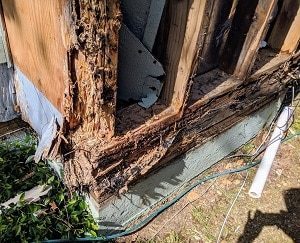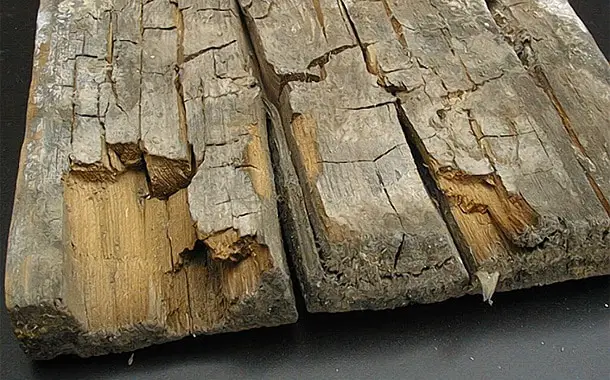How Much Does Dry Rot Repair Cost?
Last Updated on February 18, 2024
Written by CPA Alec Pow | Content Reviewed by ![]() CFA Alexander Popinker
CFA Alexander Popinker
Dry rot is a serious issue that can wreak havoc on any wood structure. Understanding the average costs of dry rot repair is key to budgeting properly for this critical home maintenance project.
Repairing dry rot in a timely manner is essential to prevent further decay and preserve the structural integrity of the building.
Dry rot is a fungal infection that breaks down the wood fibers, causing decay that appears crumbly. If left unchecked, dry rot can spread rapidly, leading to large-scale damage that requires expensive repairs.
How Much Does Dry Rot Repair Cost?
On average, dry rot remediation costs $500 to $1500 per affected area. However, costs can vary widely depending on the extent of the rot and required repairs.
According to Homewyse, for example, the cost to repair dry rot starts at $525 – $987 per repair.
Porch writes that the cost to repair dry rot starts at $354.85-$753.23 per repair.
SFW Construction notes that for minor cases of dry rot, the cost typically ranges from $1,500-$2,800. However, more extensive repairs in structurally significant areas could range from $4,500 to $12,000.
Homeyou writes in an article that the cost estimates for wood rot repair in Dallas, TX, range from $1,500 to $3,000.
Factors That Determine Dry Rot Repair Costs
Several key considerations determine how much you will pay for dry rot remediation:
Extent of the Dry Rot Damage
The more widespread the dry rot, the higher the repair bill. Limited dry rot in one corner may cost a few hundred dollars. However, extensive dry rot affecting floors, walls, and roofing can cost tens of thousands of dollars to fix completely.
Careful inspection is required to map all affected areas for accurate estimates.
Location of the Rot
Dry rot in easily accessible attic space is far cheaper to repair than rot hidden behind walls or under subflooring. Labor accounts for 50-70% of total repair costs. Accessing decayed wood in cramped areas takes more time and work, driving up the price.
Type of Wood Affected
Dry rot spreads more quickly in softer woods like pine than in hardwoods like oak or cedar. The type of lumber used in your home’s construction impacts how much material must be replaced. Softwood repairs average $700 per affected area versus $200 for hardwoods.
Severity of Structural Damage
If the dry rot has severely compromised walls, floors, or the roof structure, major repairs like sistering joists or replacing large sections are needed. Structural restorations can cost $10,000 or more depending on the scope of work. Preventative treatment of surface-level rot is far more affordable.
You might also like our articles about the cost of building a house, reupholstering a chair, and restoring furniture.
Specialist Drying or Disinfection Treatments
In severe cases, drying out services or disinfecting with fungicide may be recommended, at a cost of $500-1000 per day. These services speed up the repair timeline but are not always mandatory.
Home Improvements to Correct Moisture Issues
You may need additional home improvement projects to tackle excess moisture enabling the dry rot. Added costs for improved ventilation, insulation, drainage, vapor barriers, or other moisture control solutions should be included in your budget.
DIY vs Professional Dry Rot Repair
Can you save money by repairing dry rot yourself? Let’s compare the costs:
DIY Dry Rot Repair
DIY repairs for minor dry rot cost $150-300 on average. You avoid paying labor, with material costs for replacement lumber, protective sealants, and tools being your main expenses.
Watching tutorials can teach you how to identify and treat dry rot. However, mistakes made due to inexperience can lead to the rot worsening and more expensive future repairs. Major structural repairs are best left to the professionals.
Professional Dry Rot Repair
Hiring a contractor to handle dry rot remediation averages $1,500-$3,000 per affected area, depending on damage severity. You pay for their expertise in accurately diagnosing the issue, restoring structural stability, and preventing recurrence.
While the hourly labor rate of $50-$100 raises costs, professionals get the job done quickly and correctly. They also provide warranties and take liability for any issues. Paying more upfront saves you money over time.
For large dry rot infestations affecting critical structural components, professional repair is strongly advised. The potential for collapse and other dangers are too high to DIY.
Additional Dry Rot Repair Cost Considerations
Beyond the infected areas, additional costs may stem from your dry rot issues:
- Inspection fees – Professional assessment and testing to find all rot typically costs $200-300.
- Preventative treatment – Applying fungicide to uninfected at-risk areas runs $3-5 per square foot.
- Architect and engineering fees – For severe structural damage, design and evaluation by professionals cost $200+ per hour.
- Permit fees – Major structural restorations require building permits, which average $800.
- Temporary displacement – Extensive repairs may require moving out during work, which adds relocation and storage fees.
- Insurance claims – Filing claims for dry rot damage repair increases premiums by 10-15% per year typically.
Adding just 5-10% contingency funds to your dry rot repair budget helps cover unexpected costs.
Tips for Reducing Dry Rot Repair Costs
You can control expenses by taking the following cost-saving steps:
- Detect early – Catching dry rot early keeps damage localized and repair costs low. Inspect regularly and fix small issues immediately.
- Improve ventilation – Boosting air circulation inhibits fungal growth. Increase vents, fans, and dehumidification to prevent new rot.
- DIY minor repairs – For surface-level rot in easily accessible areas, DIY can save 50-70% over hiring contractors.
- Get multiple bids – To find the best rate, get written repair quotes from at least 3 reputable professionals.
- Use less expensive materials – Ask contractors if decay-resistant hardwoods like cedar can substitute for pricier alternative lumber types.
- Ask about apprentice labor – Some contractors offer repairs by apprentices under journeyman supervision at discounted hourly rates.
- Offer to assist – Volunteering to help with demolition or material moving reduces labor hours billed.
Finding and Hiring a Dry Rot Repair Contractor
 Follow these guidelines to find a trustworthy, experienced dry rot repair contractor:
Follow these guidelines to find a trustworthy, experienced dry rot repair contractor:
- Check reviews – Online reviews highlight the best and worst companies. Search “[city] dry rot repair” and read feedback carefully.
- Confirm licensing and insurance – Licensed, bonded, and insured contractors do quality work and cover damages. Verify coverage.
- Look for dry rot expertise – Search for companies specializing in dry rot with many years handling large cases. They know how to fix it right.
- Get at least 3 written estimates – Do in-person walkthroughs with multiple contractors and require detailed bids based on the full scope.
- Ask lots of questions – Interview contractors thoroughly about their methods and materials. Reputable companies happily answer.
- Confirm guarantees – The best companies provide long guarantees against new rot. Opt for contractors guaranteeing their repairs for 5+ years.
Though labor drives up costs, hiring the right contractor actually saves money in the end through their efficient repairs and effective prevention of future dry rot outbreaks.
Final Words
If left untreated, dry rot poses a serious threat to your property’s structural integrity and value. While repairs may seem expensive, addressing decay promptly is far more affordable than letting the rot spread until major restoration is required.
Investing in professional repair as soon as dry rot appears gives you peace of mind that your investment is protected.
With some diligent research and cost-saving measures, you can get your dry rot woes fixed fast without overspending. Keep watch to catch rot early and take immediate action at the first sign of fungal wood decay.
Though fixing dry rot requires an initial outlay, preserving your building today prevents exponentially higher expenses down the road.
Frequently Asked Questions
Can dry rot be cured?
Yes, dry rot can be cured through a combination of removing infected wood and applying fungicidal treatments. Here are the basic steps for curing dry rot:
1. Inspection – Have a professional contractor inspect the full extent of the dry rot damage. Probing tools and moisture meters help identify all affected areas.
2. Removal – Remove all wood materials showing signs of fungal decay. This includes studs, sheathing, trim, and framing. Remove 2 feet beyond visible rot to be safe.
3. Disinfection – Apply EPA-registered fungicide to kill remaining spores in surrounding wood. Borates or copper compounds work well for wood disinfection.
4. Drying – Use fans, heaters, and dehumidifiers to fully dry out the area for 1-2 weeks, reducing moisture below 15%.
5. Replacement – Install new pressure-treated wood to replace damaged framing, sheathing, and trim. Cedar or redwood last longest.
6. Moisture Control – Improve ventilation and humidity control to prevent more rot. Direct rainwater and condensation away from wood.
With this comprehensive cure process, the fungal infection can be eliminated and the dry rot damage repaired for long-lasting results. Ongoing maintenance helps prevent recurrence.
What are the 4 stages of dry rot?
Dry rot progresses through the following 4 stages if untreated:
1. Surface Discoloration – Early stage dry rot causes dark spots and tan or gray discoloration on the wood surface. This stage is the easiest and cheapest to repair.
2. Soft Spongy Wood – The wood develops a soft, crumbly texture with cube-like cracking as the rot advances. Wood strength is compromised.
3. Sunken Areas and Fruiting Bodies – Crumbling areas appear sunken. White fungal masses called fruiting bodies may extrude from infected sites.
4. Large Cracks and Voids – The final stage shows large cracks, voids, and extreme wood fiber breakdown, severely weakening structural integrity.
Catching dry rot in the first 1-2 stages allows inexpensive spot treatment. Once stage 3-4 structural damage occurs, extensive repairs are needed to restore strength.
Is dry rot an emergency?
Dry rot often spreads rapidly once started but rarely constitutes an emergency on its own. The following scenarios do require urgent repair:
- Crumbling dry rot affecting critical structural members like bearing walls, posts, joists, or roof rafters
- Sagging floors, ceilings, or roofs indicating advanced structural weakness
- Signs the infected wood may collapse, like severe cracks and 10%+ moisture content
- Dry rot compromising stairs or decking, increasing fall or injury risks
- Electrical or plumbing damage caused by spreading fungal decay
- Dry rot in a frequently occupied area releasing spores that could cause respiratory issues
- Recent acceleration of the rot after a moisture event or temperature change
Unless the rot poses an imminent collapse or health risk, it is not an emergency. However, rapid expert assessment and repair initiation is important to prevent worsening.


Thanks for helping me understand that professional wood rot repair in a single location can cost around $100 to $300. I will share this information with my sister since she told me that she has a rotting issue in her deck. It might be due to their area being prone to rain and humidity, especially during these days.